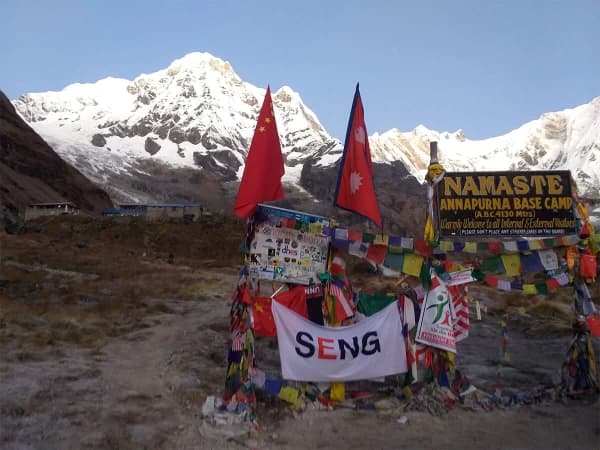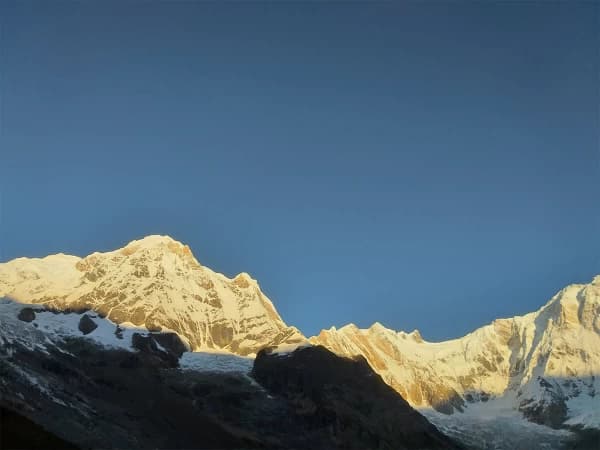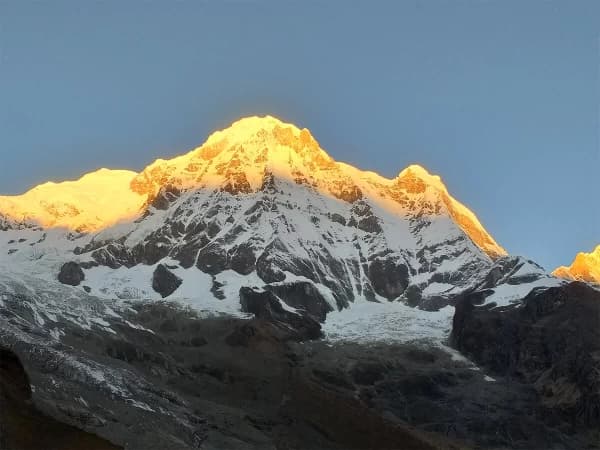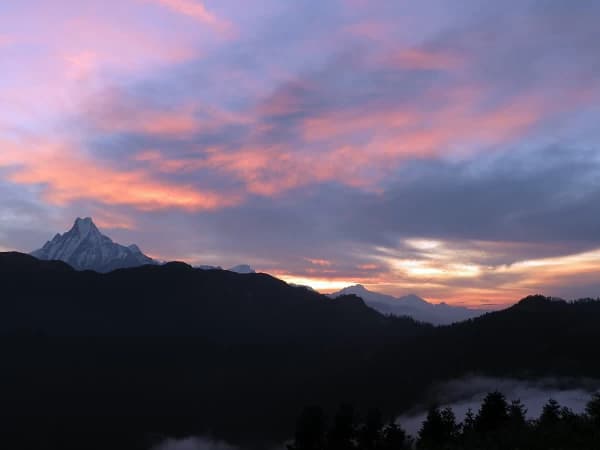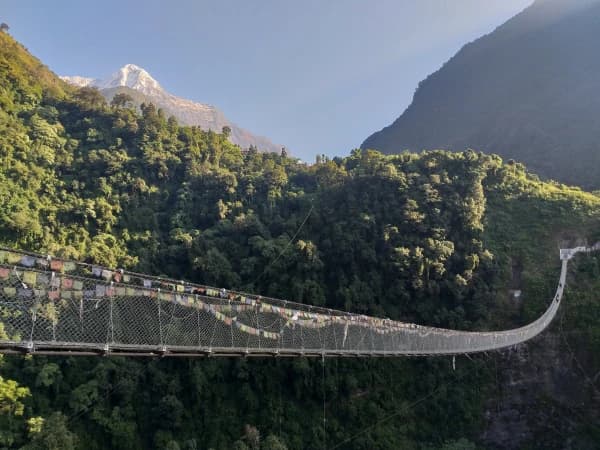The Annapurna Base Camp is one of the more popular treks in Nepal, and for a good reason! The trail takes you through the foothills and upwards to the Himalayas, where the last stop is the base camp (4130m) for Annapurna I, which at 8091m is the 10th highest peak in the world. As you make your way to the base camp, you walk along the Modi Khola (river) provides an amazing look into the difference in terrain from the high mountains to the river valley below.
As you travel from the low hills to the mountains, you see the rich biodiversity and terrain of Nepal in just a total of seven days of trekking. The trek passes through the base camp of Machhapuchhre, an iconic mountain whose name literally translates to ‘fishtail’ for the unique shape of its peak. On the way back, you also pass by hot springs at Jhinu Danda, where you can rest amidst nature.
Seven days of trekking also means that this is a shorter trail, especially for those who may not have a full two weeks on their schedule to do a trek. It is also an accessible one and falls within moderate difficulty, which means that as long as you are fairly physically active, you will not have any issues on this trek. This trail can also be relatively more comfortable and luxurious as compared to other treks in Nepal due to its popularity and ease of access so it is also a great starting trek for those who want to know more about the Himalayas and trekking in Nepal.
The Annapurna Base Camp trail also passes by the Annapurna Sanctuary, which is a historically and culturally significant place where pilgrimages are made and is especially holy for the indigenous Gurung people in the region. This sanctuary, which is a high glacial basin, is considered to be the resting place of gods, both Hindu and Buddhist, as well as other animistic ones.
Highlights:
- Get up close and personal with the Himalayas where you can see panoramic views of some of the highest peaks in the world: Dhaulagiri (8167 m), Annapurna I (8091m), Annapurna II (7937m), Annapurna III (7555m), Annapurna IV (7525m) and Annapurna South (7219m).
- One of the most memorable moments is watching the sunrise over the Annapurna massif from the base camp, where the mountains are bathed in a golden glow.
- A variety of side trails and stops, which means you can shorten or lengthen your trip depending on your schedule and how much you want to challenge yourself.
- You will pass by the Machhapuchhre Base Camp which gives you an intimate view of the Mt. Machhapuchhre, a unique peak in its shape, but it has never been climbed before.
- The trek passes through traditional villages inhabited by the Magar and Gurung communities, offering insights into their culture, customs, and ways of life.
- A stop by the beautiful and intricately made Buddhist stupa in the village of Chhomrong.
- Cross the Jhinu Danda suspension bridge, one of the longest in the world at 287 meters.
What can I expect from the Annapurna Base Camp trek?
The Annapurna Base Camp trek offers you a glimpse into the Himalayas with various trails where you can choose your own adventure. You can adjust your trip based on the number of days you want to spend on the trail, from quaint villages to comfortable mountain lodges and rest stops below snow-clad peaks. It is an ancient trail that is culturally significant to Hindus, Buddhists, and the indigenous Gurung people in the region (the name ‘Annapurna’ refers to the Hindu goddess of food and nourishment).
This trek is a popular ‘gateway’ trek for beginners who want to try trekking in Nepal. The maximum altitude you reach during this trek is 4130m at Annapurna Base Camp, which is at a much lower altitude than the Everest Base Camp (5364m) and the Thorong La Pass (5416m) at the Annapurna Circuit. So if you want to start with an accessible trek with a higher rate of success, this is the trek for you! Of course, as with any trek in the Himalayas, it will need a certain level of fitness and since this trail is known for its numerous stone steps, we advise you to get some basic training in before your journey.
Major Attractions of the Annapurna Base Camp Trek
You begin your journey in Kathmandu, which hosts a plethora of cultural and historic landmarks and festivals. From the iconic Kathmandu Durbar Square, which dates back to the 4th century, to the charming Boudha Stupa (also dating back to the 4th century), you will never have a dull day in the capital city. From here, we leave for Pokhara, the tourist capital of Nepal.
The trek takes you to quaint villages like Jhinu Danda which you will have to pass a whopping 287 meter long suspension bridge, one of the longest in Nepal! The Jhinu Danda village also has a hot spring for you to enjoy on your way back from the base camp.
Who can do the ABC Trek?
The ABC Trek is considered a great trek for beginners and seasoned trekkers along and is classified as moderate to easy. Due to its accessibility, popularity, and fairly safe terrain, it is ideal for people from all walks of life whether you are just starting out or are a veteran trekker. Age is no bar for the Annapurna Base Camp however minors under the age of 18 will need an adult guardian.
We welcome enthusiastic trekkers from all over the world. You can choose to trek with your friends, partner, and family. If you plan to do a solo trek, you will be accompanied by a guide and/or a porter (depending on your need for one).
If you choose to do a group trek, you will be included in a group with other trekkers. Depending on your preference, you can choose to do either a group trek (open to others) or a private trek just for your group. To reiterate, we consider this trek to be a versatile one and welcome everyone from families, students, retirees, and everyone in between!
Preparation before the Annapurna Base Camp trek
Since the ABC Trek falls between easy to moderate difficulty, we believe that you don’t need to be extremely fit for this trek, as long as you walk the trail at your pace, keep well hydrated and well rested with proper clothing, you will reach your destination.
That being said, fitness training for at least 2 or 3 months before your trip will always be beneficial for you and make the trek less strenuous. Exercises can include using star climbers, walking on an incline on a treadmill, strength training, and any form of cardio you enjoy like hiking, swimming, cycling, or running.
The goal here is to build your stamina and endurance so you feel better in your body and during the trek.
Trip Nutshell
- Trek Duration: 5 days from Pokhara to Pokhara.
- The trek starts from Jhinu Danda.
- Trek ending point is Jhinu Danda.
- Elevation: Annapurna base camp 4,130 meters (13,550 feet) above sea level.
- Located: Annapurna Conservation Area, northwest of Pokhara, Nepal.
- The trek distance is approximately 58 kilometers (36 miles).
- Popular route to Annapurna Base Camp.
- Offers panoramic vistas of the Annapurna Himalayan range.
- Trek passes through terraced fields and lush forests.
- Socialize: Local Gurung and Magar communities.
- Opportunities: Experience local culture, architecture, and hospitality.
- Ideal Seasons: Spring and autumn are the best times for the Annapurna region.
- Weather: Generally stable weather and clear skies during these periods.
- Accommodation & Facilities: Teahouses and lodges along the trekking route.
- Food: Local cuisine is available and also western food.
- Safety and Challenges: Less risk of altitude sickness than other treks.
- Permit: TIMS Card and ACAP Permit.
- Transportation: By road or a short flight from Kathmandu to Pokhara.
- Biodiversity: Various species of flora and fauna (rhododendrons, orchids…), and rare animals.
- Trek category: The Annapurna Base Camp trek is moderate.
Ready for the experience of a lifetime?
Now that you have gotten an idea of trekking to the Annapurna Base Camp, join us for an amazing journey to the Himalayas. Iconic Himalaya has been in the tourism and trekking industry for over 20 years. We have supported over numbers trekkers in curating exciting, fulfilling, and often life-changing treks in the Annapurna region. You can trust us to make your trip the experience of a lifetime!
